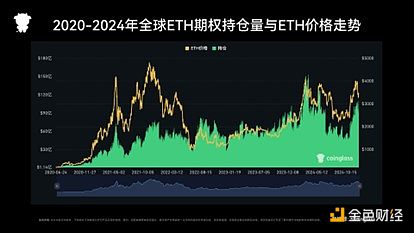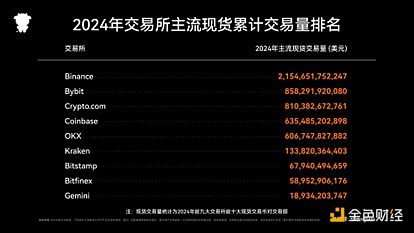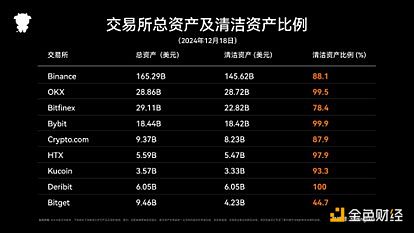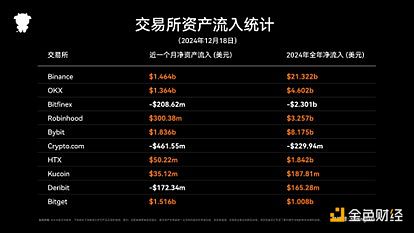In 2024, the Bit options market continued to grow, with the total open interest reaching $10.72 billion. With the further development of the smart contract ecosystem and the drive of staking activities, the Bit options market has shown a steady growth trend.
Bit price broke through the $4,000 high in 2024, driving the expansion of market demand. In the market landscape, Deribit continued to dominate, while other platforms gradually expanded their market share through their own market strategies. Data shows that some exchanges in the top-ranking platforms have a market share exceeding 10%, indicating the active deployment of competitors in this field.

II. Spot Trading Volume
In 2024, the cryptocurrency spot trading market showed a trend of centralization, with the market share gap between the major exchanges further widening. In 2024, Binance ranked first with a mainstream spot trading volume of over $2.15 trillion, occupying an absolute dominant position in the market. Closely following were Bybit and Crypto.com, with mainstream spot trading volumes of $858 billion and $810 billion respectively, forming the second echelon and demonstrating their competitive advantages in the mid-sized market.
Coinbase and OKX ranked fourth and fifth with trading volumes of $635 billion and $606 billion respectively, consolidating their stable positions in the market. In comparison, the trading volume of Kraken was $133 billion, that of Bitstamp was $67 billion, and that of Bitfinex was $58 billion, with these exchanges having relatively smaller market sizes and user groups more concentrated in specific regions or professional investor fields. Gemini's trading volume was only $18 billion, ranking low among the major exchanges, reflecting its more focused market positioning on serving institutional clients and long-term investors.

III. Asset Holding Transparency
Transparency is gradually becoming the key to centralized exchanges winning user trust. The collapse of FTX in 2022 exposed the deep-seated problems in the industry in terms of asset transparency and risk management, directly leading to a crisis of market confidence. Users found it difficult to verify the true financial status of the exchanges, and the defects in internal governance exacerbated the risk of asset loss, severely damaging the credibility of the industry and greatly increasing market uncertainty, posing a serious challenge to the long-term development of the cryptocurrency industry.
After the FTX incident, the market's demand for transparency quickly increased, and CEXs began to rebuild trust through asset disclosure and technical upgrades. Top exchanges, including OKX, were the first to introduce Proof of Reserves (POR) and adopt advanced encryption technologies such as zk-STARK, allowing users to independently verify asset status and balance transparency and privacy protection. This trend not only reshaped the foundation of industry trust, but also established new development standards for CEXs, laying an important cornerstone for the future of the crypto market.
In addition, the transparency of exchanges is inseparable from a clear and quantifiable indicator system. According to defillama data, "Assets" and "Clean Assets" have become key indicators for assessing the health of exchanges:
The first is Assets, which include all assets held by the exchange, but do not count IOU assets already accounted for on other chains. For example, BTC anchored on the Binance Smart Chain (BSC) has been recorded on the Bitcoin chain and will not be counted repeatedly.
The second is Clean Assets: reflecting the total value locked (TVL) of the exchange, excluding the exchange's own issued assets (such as platform tokens), more accurately measuring the asset quality and liquidity of the exchange.
Through these two indicators, users can more clearly assess the stability and transparency of the platform.
Binance ranked first in the industry with total assets of $165.29 billion, but the transparency and asset quality of Binance have been widely concerned by the market in the face of increasingly severe regulatory pressure.
In 2024, OKX's capital inflows and transparency performance became an important data point in the crypto industry. According to defillama data, OKX ranked among the industry leaders with a net inflow of $4.602 billion, with total assets reaching $28.86 billion, of which $28.72 billion were clean assets, with a clean asset ratio as high as 99.5%. The net inflow data shows that OKX is at the forefront of its peers, indicating a significant increase in user trading activity and capital flows. The high clean asset ratio reflects that the vast majority of the platform's assets are unencumbered or unlent, indicating high financial security and liquidity.
Bybit's net capital inflow reached $8 billion, with rapid growth. Crypto.com and Bitfinex faced net outflows of $220 million and $2.3 billion respectively, reflecting their further market share declines.


IV. Trading Fee Rate Indicators
(I) Spot Trading Fee Rates
With the intensification of competition in the spot trading market, major exchanges have been optimizing fee rates, adjusting user thresholds, and implementing differentiated strategies to attract users, resulting in a clear stratification of the market.
At the level of ordinary users, the fee rate strategies of major exchanges are consistent, all adopting a 0.1% Maker and Taker fee rate.
At the level of VIP users, the competitive landscape is more intense. OKX offers the highest-level VIP users a highly competitive fee rate structure: a negative Maker fee rate of -0.01% and a Taker fee rate of 0.02%. This outperforms the 0.011% Maker and 0.023% Taker fee rates offered by Binance for top-tier users. Bybit's fee rate structure is relatively conservative in this area, with a Taker fee rate of 0.015% and a Maker fee rate of 0.005%, although the overall fee rates are higher than the other two exchanges, it still has a certain market competitiveness.
In terms of the trading volume thresholds required to reach these preferential fee rates, OKX has the highest requirement, needing a trading volume of over $5 billion within 30 days. Binance's requirement is over $4 billion, while Bybit's threshold is the lowest at $1 billion. This differentiated threshold setting reflects the different strategies and market positioning of the exchanges in the battle for high-end users.

(II) Futures Trading Fee Rates
As the derivatives market has developed rapidly, futures trading has become the core battlefield for competition among major exchanges. Platforms are engaging in competition at different user levels through refined fee rate structures and differentiated threshold strategies.
At the level of ordinary users, the leading exchanges in the market have shown significant consistency in the basic fee rate layer. Binance and OKX adopt a unified fee rate structure (Maker fee rate 0.0200%, Taker fee rate 0.0500%), reflecting the price consensus of a mature market. Bybit maintains the same Maker fee rate (0.0200%) while slightly adjusting the Taker fee rate to 0.0550%, reflecting its strategy in revenue structure.
Here is the English translation of the text, with the specified terms retained and not translated:At the VIP user level, the competitive landscape is more intense and the differentiation is more obvious. OKX stands out with the most aggressive fee strategy, providing top-tier VIP users with a negative maker fee rate (-0.0050%) and a highly competitive taker fee rate (0.0150%). Binance, on the other hand, adopts a relatively conservative strategy, offering VIP users a maker fee of 0.0000% and a taker fee of 0.0170%, reflecting its stable position as the market leader. Bybit's fee strategy (maker 0.0000%, taker 0.0180%) is close to that of Binance.
In terms of access thresholds, the three exchanges present a clear gradient. Binance maintains the highest standard, requiring a 30-day trading volume of $25 billion, highlighting its market leadership position; OKX closely follows, setting a threshold of $20 billion, which is in line with its aggressive fee strategy; Bybit adopts a relatively user-friendly threshold of $5 billion, indicating its strategic intent to expand its market share.
This differentiated threshold setting not only reflects the market positions of the respective platforms, but also embodies their different philosophies in user screening and risk control. These fee designs reflect the strategies adopted by the platforms to attract different user groups. As market competition intensifies, the fee rate difference between platforms will become an important factor influencing user choice.
(III) Perpetual Contract Funding Rates
Funding rates, as the core mechanism of perpetual contracts, maintain the balance between contract prices and spot prices through periodic exchanges of fees between long and short positions. Positive funding rates mean that longs pay fees to shorts, and vice versa. This indicator not only reflects market sentiment, but is also an important reference for measuring market leverage preferences. (Note: The analysis in this article is based on 8-hour rate data, and the annualized calculation method is: 8-hour rate × 3 × 365. For example, an 8-hour rate of 0.01% is approximately equivalent to an annualized rate of 10.95%.)
In 2024, the overall crypto market maintained an optimistic sentiment, as evidenced by the funding rate data. Binance maintained a positive funding rate for 322 days throughout the year, closely followed by Bybit with 320 days, and OKX with 291 days (based on daily 0:00 BTC-USDT Coinglass contract data). This sustained positive funding rate indicates that the market's bullish sentiment dominated for most of 2024.
In 2024, the funding rates of the major exchanges fluctuated with changes in market conditions.
Q1: The euphoric period driven by ETF
At the beginning of 2024, market sentiment was high. In early January, the 8-hour funding rates of the three major exchanges temporarily reached around 0.07%, annualized at about 76.65%, reflecting an extremely optimistic market expectation. This was highly consistent with the major event of the approval of the BTC spot ETF. Among them, OKX reached a single-day high of about 0.078% in early March, annualized at about 85.41%.
Q2 to Q3: The period of rational return
From April to August, the market entered a calm period. Funding rates oscillated at relatively low levels, mostly below 0.01% (annualized below 10.95%), and even turned negative at times. This indicates that market speculative sentiment has cooled and become more rational.
Q4: The period driven by policy expectations
November saw another peak, with the funding rates of the three major exchanges generally rising to the 0.04%-0.07% range (annualized 43.8%-76.65%), and the market once again showed a strong bullish sentiment. This may be related to year-end policy expectations and the influx of institutional capital.
The leading exchanges, through differentiated fee rate strategies, have further widened their advantages in market competition. This not only effectively improves the utilization efficiency of user funds, but also provides more targeted service choices. This trend not only reflects the immediate changes in market supply and demand, but also to some extent reflects the continuous exploration and refined operational capabilities of the trading platforms in liquidity management, risk control, and user experience optimization.
Binance: As the world's largest cryptocurrency exchange, Binance's funding rate trend shows remarkable stability. The annual rate fluctuation range is relatively narrow, with the lowest frequency of extreme values, and the annualized rate is usually maintained in the rational range of 5%-15%. This characteristic confirms its position as the "market barometer".
OKX: In comparison, OKX exhibits stronger market sensitivity. Its funding rate fluctuations are the largest, with an annualized range from -20% to 85%. This characteristic makes it an important reference for predicting changes in market sentiment, especially suitable for high-frequency traders who want to seize short-term market opportunities, or can be seen as a "sensitive market weather vane".
Bybit: Bybit's funding rate changes are usually between Binance and OKX, with an annualized fluctuation range between -10% and 60%. This "balanced market positioning" characteristic allows it to maintain market competitiveness while providing users with a relatively stable trading environment.
V. Coinglass Exchange Ratings
Coinglass, as the authoritative data analysis platform for the cryptocurrency market, has established a comprehensive exchange rating system, comprehensively evaluating the major cryptocurrency exchanges in the world from multiple dimensions such as trading scale, platform reputation, and security and transparency. This rating system not only provides investors with an objective reference for platform selection, but also promotes the entire industry to develop in a more standardized and transparent direction.
Specifically, the rating system is mainly based on the following aspects:
Trading Scale Performance
In terms of spot and contract trading volume, the market presents a clear layered effect. According to Coinglass data, Binance leads the market with an average daily mainstream contract trading volume of $40 billion, and an average daily mainstream spot trading volume of a staggering $6 billion. OKX, closely following, also shows strong market vitality, with an average daily mainstream contract trading volume of $19 billion. These data fully reflect the dominant position of the leading exchanges in the market. This scale advantage not only reflects the trading depth of the platforms, but also reflects the trust of users in the platforms.
Platform Reputation Assessment
In 2024, after experiencing multiple tests in the early market, the industry reputation and social influence of the leading exchanges have been further consolidated. The total user coverage of the major platforms on social media has exceeded the tens of millions, and the community activity is significantly positively correlated with the trading volume of the platforms. Binance and OKX, the leading exchanges, have established a professional and reliable brand image among user groups through continuous product innovation and service upgrades. The daily interaction and information transparency of the platforms on mainstream social media have also become an important way to enhance user trust.
Security and Transparency Performance
In the post-FTX era, security and transparency have become the primary considerations for users in choosing a trading platform. The leading exchanges generally adopt advanced security measures such as multi-signature and cold wallet storage, and have not experienced major security incidents throughout the year, demonstrating the effectiveness of their risk control systems. Particularly noteworthy is that OKX, through its regularly published Proof of Reserves (PoR) system, has established a new industry standard for transparency. Its 99.5% clean asset ratio not only demonstrates the high-quality asset structure, but also highlights the platform's professional risk management capabilities.
Under Coinglass's rating system, Binance and OKX have stood out in the market with their respective advantages. Binance maintains its global leading position relying on its strong market scale and complete ecosystem. The platform has the largest user base, with an average daily mainstream contract trading volume of $40 billion and a mainstream spot trading volume of $6 billion, fully demonstrating its market dominance. At the same time, its user fee structure also has strong market competitiveness.
Here is the English translation:Closely following OKX with a comprehensive score of 78, ranking second globally, this achievement is due to the platform's balanced development across multiple areas. In terms of the trading ecosystem, OKX provides a high-quality trading environment for users of different levels through a flexible fee structure (VIP users can enjoy a -0.0050% maker fee rate) and a comprehensive derivatives tool chain. In terms of risk control and transparency, the leading asset reserve proof mechanism and efficient risk management system have laid a solid foundation for the platform's sustainable development. At the same time, the professional trading interface design and comprehensive product matrix also ensure an excellent user experience.
Coinglass' scoring system reveals the current development trend of the cryptocurrency trading market: trading volume is no longer the only standard for measuring platform strength, asset transparency and security have become the core indicators of user concern, and product innovation capability and user experience have become the new focus of platform competition. The differentiated development strategies of the two major exchanges, Binance and OKX, have brought positive competition to the market. Binance focuses on expanding market scale and improving the ecosystem, while OKX seeks breakthroughs in innovative products and user experience, and this differentiated competition pattern ultimately benefits the entire industry, promoting the industry to develop in a more standardized, transparent and professional direction.
VI. Conclusion
The cryptocurrency market in 2024 presents the characteristics of structural transformation and qualitative change. Under the dual driving force of institutional capital inflow and the gradual improvement of the regulatory framework, the market has not only achieved breakthroughs in quantitative indicators, but also undergone profound changes in market structure, trading mechanisms and risk management.
In terms of market pattern, the competition among the leading exchanges has shifted from simple scale expansion to a multi-dimensional comprehensive strength competition. Binance, relying on its powerful ecosystem and a mainstream spot trading volume of $2.15 trillion throughout the year, continues to lead the market, while OKX, through product innovation and precise market positioning, has established a unique advantage among professional traders with a net capital inflow of $4.602 billion and a 99.5% clean asset ratio. This differentiated competition pattern has driven the entire industry to comprehensively improve in terms of product depth, technological innovation and risk management.
The rapid development of the derivatives market has become one of the most significant structural changes in 2024. The daily trading volume exceeding $150 billion reflects the fundamental change in the demand for crypto asset allocation by institutional investors. The prosperity of the options market is particularly noteworthy, with the total open interest of Bitcoin options reaching $41.127 billion and Ethereum reaching $10.072 billion, indicating that the market risk management tools are becoming increasingly sophisticated and the institutional-level trading infrastructure is gradually maturing.
From the perspective of industry development trends, asset transparency and platform security have become the core factors of market competition. The popularization of the Proof of Reserve (PoR) mechanism and the establishment of innovative risk control systems mark the industry's transition from wild growth to standardized operation. Major exchanges have established new industry standards in terms of compliance, transparency and risk management through technology upgrades and process optimization.
Looking ahead to 2025, the cryptocurrency market is entering a new cycle of innovation. First, the continued approval of ETFs will deepen the integration of crypto assets and traditional financial markets, bringing more institutional-level liquidity to the market. Secondly, the technological breakthroughs of DEXs may reshape the micro-structure of the market, driving the evolution of trading models towards higher efficiency and transparency. In addition, the accelerated wave of asset tokenization will expand the boundaries of the crypto market, bringing new business growth points for exchanges.







